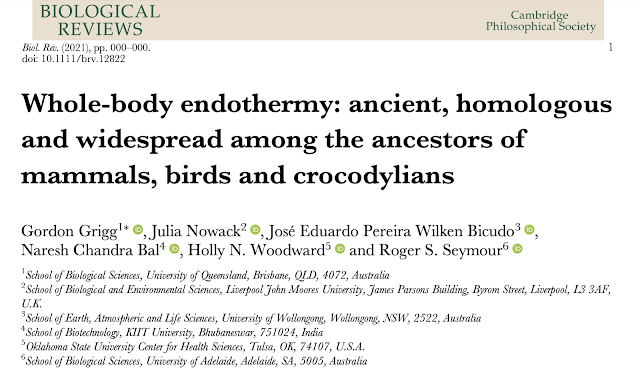Claud Bernard’s dictum, La fixité du milieu intérieur est la condition de la vie libre et indépendante…, developed in the latter half of the 19th century has dominated thinking on the importance of constancy of the internal environment and of the mechanisms used, homeostasis, to maintain it. The corollary in evolutionary terms is that in terms of temperature regulation mammals and birds are at the peak of physiological efficiency. They generate heat from metabolic processes and keep their body temperature within fine limits.
Anything less than the mammalian and avian perfection of maintaining a stable body temperature has been viewed as a liability. After all it is self evident that at lower temperatures the ‘cold-blooded’ or poikilothermic vertebrates which do not generate sufficient heat internally cannot move so quickly and avoid predation, for example. That is all a simple matter of the effects of temperature on chemical reactions. Therefore, extant reptiles and amphibians have been looked on as relics of an inferior system of temperature generation and control with many of them using behavioural means to garner heat from the sun.
The view that reptiles had never developed the ability to generate heat was challenged fifty years ago by the suggestion that dinosaurs were warm-blooded in that they could generate heat internally (endothermy) rather than rely on heat from the environment (exothermy). Arguments have continued on whether new bits of evidence from the fossil record supports ectothermy, endothermy or something in between.
The generally accepted view of the mechanism of endothermy is that it must have arisen independently in the the evolutionary lines that ended up as mammals and birds and involved different biochemical mechanisms and tissues; indeed it is often referred to as an example of parallel evolution. The new paper turns that view on its head. In their scheme the authors suggest that the precursors of mammals and birds, as well as other reptile groups, had developed endothermy and that mammals and birds generate heat by a similar ancestral mechanism.
I will not go further into the extensive arguments the authors have mustered in support of their hypothesis but it does extend to take into account the structure and function of the circulatory system in mammals, birds and reptiles, for example.
If endothermy was, as the authors suggest, the ancestral condition, the question that arises is why animals like modern crocodilians have become cold-blooded animals more recently. Ectothermy (poikilothermy in old money) is highly efficient in metabolic terms. Reptiles have much lower metabolic rates than mammals of the same size and therefore require much less food. For ambush predators with an intermittent food supply that could be of great selective advantage.
 |
| A Mugger (Crocodylus palustris) basking in the sun at Sigiriya, Sri Lanka in 2013 |
 |
| Another Mugger in Yala National Park, Sri Lanka, 2013 |
Again if the authors are correct, we have to stop thinking of reptiles as losers in the race to develop endothermy and therefore enjoy Claud Bernard’s la vie libre et indépendante. You need a lot of energy from food or fat stores to be an endotherm and when the going is tough, loss of endothermy and la vie libre could well have been the evolutionary trade-off.
The paper by Gordon Grigg, Julia Nowack, José Eduardo Pereira Wilken Bicudo, Naresh Chandra Bal, Holly N. Woodward and Roger S. Seymour from universities in Australia, UK, India and the USA will promote a great deal of discussion across a wide range of disciplines. I think it is a case of watch this space.
Grigg G, Nowack J, Bicudo JEPW, Bal NC, Woodward HN, Seymour RS. 2021. Whole-body endothermy: ancient, homologous and widespread among the ancestors of mammals, birds and crocodylians. Biological Reviews doi.org/10.1111/brv.12822

No comments:
Post a Comment